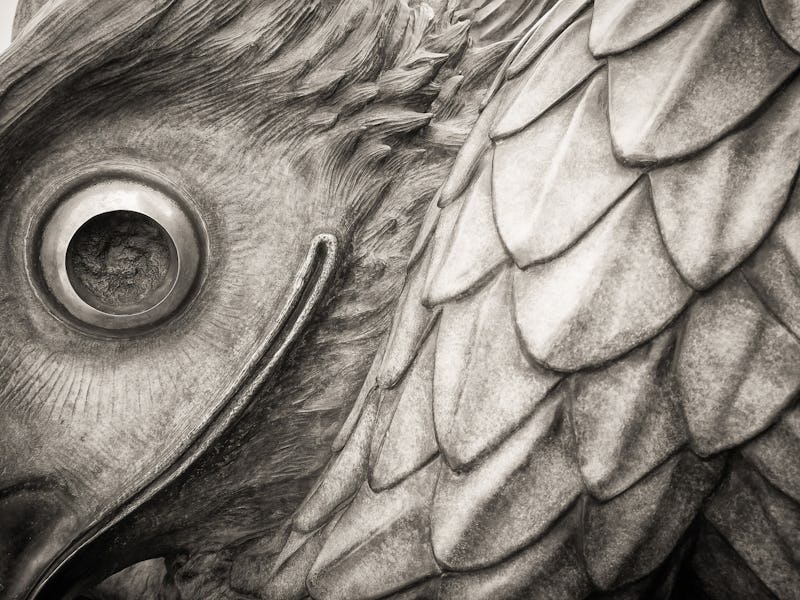The Future Robot Is a Mythological Animal
Yes it sounds creepy, but just hear me out...

The stories are almost formulaic at this point. Engineer builds robot using [Insert Body Part] of [Insert Animal] as model. Examples: the tongue of a chameleon, spine of a snake, wings of a hummingbird.
There’s a reason engineers throw it in reverse. Animals, even simple ones, interact beautifully with the world despite having limited cognitive abilities. They are models of purpose-built function. They are optimized. For that reason, any conversation about a perfect automoton is also a conversation about splicing animals to create something new and different and better.
As a thought experiment, let’s imagine what a robotic chimera would look like, if it was composed of all the different creature features currently in development.
Vision: Fly
We’ve already written about how insect vision makes drones fly better. The reason is because while insects have a really poor resolution, they are more sensitive to seeing movements and objects in their immediate path.
This has to do with the dorsal ocelli found in the insect’s head, simple ocular structures meant to do one thing really well: detect movements in light. A team from the Harvard Microbiotics Lab has been researching this for years, and discusses how it works in their video below.
A robot that’s using “fly-vision” may not be able to immediately recognize objects or faces very well, but that’s really not the most important obstacle for robots right now. It’s getting them to move forward and react fast enough to new, unanticipated changes in the environment. Anything from oncoming vegetables being hurled at them by anti-robot hippies, to actual flies that don’t immediately see eye-to-eye with them. If you can get a robot to detect these things, you can get them to react to them more quickly as well.
Necks & Backs: Ant
Relative to their size, ants are one of the strongest animals in the world, able to withstand pressure 5,000 times greater than their own body weight. It’s an astounding feat robotics makers from all over the world want to emulate.
Of course, the reason ants are so strong has to do with why they’re so small: as body weight increases with overall volume, muscle strength only increases with surface area. That won’t stop researchers from trying to scale the process up for bigger robots, and if they’re successful, perhaps you should get ready to welcome your new insect-robot overlords. Our chimera-bot would definitely do well with an ant-like exoskeleton.
Legs: Horse, Spider, & Ostrich
Legs are perhaps one of the trickiest robot issues to deal with. There are too many options, from biped, to qudruped and beyond. And they need to be specially designed according to what you want the robot to do, whether that’s run fast, jump high, or just speed off into the air like Tony Stark.
But I’ve outlined three general purposes here that most robots are catered for, and what kind of animal part best informs how we should design it.
- Endurance: Horse
For centuries, humans have used horses as a means of transportation because of their unique balance in speed, endurance over long distances, and ability to lift and pull heavy loads. For that reason, DARPA’s LS3 robot is a quadruped whose legs are specifically inspired by the structure and movement of horses. The LS3 gallops, over smooth and rough terrain alike. This kind of system decreases the pressure on the legs and joints for less stress over long walks or runs.
- Rough Terrain: Spider
We’re normally with Ron Weasley when it comes to giant spiders, but a robot with eight legs can actually serve very well for navigating across rough terrain — even better than horse legs could. With eight pointed limbs, a spider-like robot could have a much easier time balancing over a really rocky or unstable ground, where only three legs are required to maintain balance.
- Speed: Ostrich
You think cheetah legs are the way to go for speed? Think again. Ostriches are perhaps the fastest biped animal, capable or reaching speeds of more than 40 mph. But they don’t run like most two-legged mammals. Ostriches have an extremely wide stride that allow them to get more out of each step. While humans boast a great deal of flexibility in their legs, ostriches have much more stable joints, which is more energy efficient for running on two legs.
Arms: Octopus
All cephalopods possess limbs that are extraordinarily flexible. You’ve probably already seen the videos that illustrate how the little creeps move around like jelly. Yet those same arms are strong as shit to boot — capable of tensing back up and moving swiftly to help propel the creature forward in the water, or wrap around prey till it’s dead.
Octopus arms are already being developed for surgical purposes to help navigate through delicate patient tissue. Imagine giving our robot a pair of these things on top of everything else it has — we’d have a robot doing surgery by day and fighting crime by night.
Hands: Gecko
The last thing our chimera-bot needs is hands, and there’s probably no better choice than gecko hands. Geckos are renowned for their ability to cling and climb up and down all kinds of surfaces. It’s not even so much that our robot needs to have webbed hands to get around — their limbs or other appendages simply need to mimic the kind of sticky moving abilities that geckos can do. See for yourself.
Borrowing some other traits from inchworms and other insects (hey there, ants!), that little nine-gram robot can hoist around over a kilogram of weight, while a smaller, 20 mg bot can lift as much as 500 mg.
Put all these things together, and our chimera-bot turns out to be the best thing robotics has never built. There has got to be a mad-scientist around ready to make it!